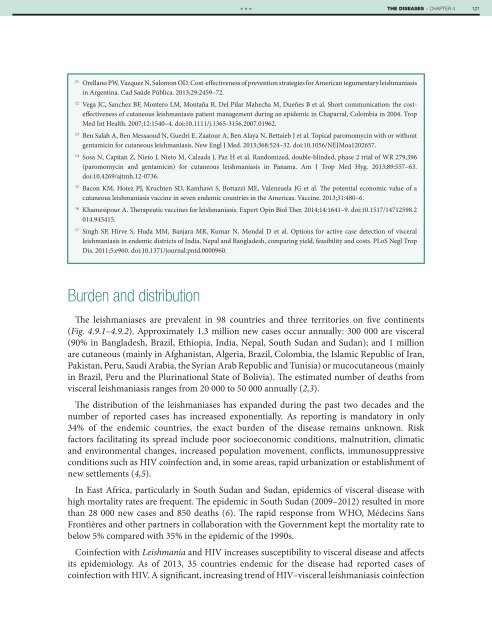1A9bnbK
1A9bnbK
1A9bnbK
Create successful ePaper yourself
Turn your PDF publications into a flip-book with our unique Google optimized e-Paper software.
***<br />
THE DISEASES − CHAPTER 4<br />
121<br />
11<br />
Orellano PW, Vazquez N, Salomon OD. Cost-effectiveness of prevention strategies for American tegumentary leishmaniasis<br />
in Argentina. Cad Saúde Pública. 2013;29:2459–72.<br />
12<br />
Vega JC, Sanchez BF, Montero LM, Montaña R, Del Pilar Mahecha M, Dueñes B et al. Short communication: the costeffectiveness<br />
of cutaneous leishmaniasis patient management during an epidemic in Chaparral, Colombia in 2004. Trop<br />
Med Int Health. 2007;12:1540–4. doi:10.1111/j.1365-3156.2007.01962.<br />
13<br />
Ben Salah A, Ben Messaoud N, Guedri E, Zaatour A, Ben Alaya N, Bettaieb J et al. Topical paromomycin with or without<br />
gentamicin for cutaneous leishmaniasis. New Engl J Med. 2013;368:524–32. doi:10.1056/NEJMoa1202657.<br />
14<br />
Sosa N, Capitan Z, Nieto J, Nieto M, Calzada J, Paz H et al. Randomized, double-blinded, phase 2 trial of WR 279,396<br />
(paromomycin and gentamicin) for cutaneous leishmaniasis in Panama. Am J Trop Med Hyg. 2013;89:557–63.<br />
doi:10.4269/ajtmh.12-0736.<br />
15<br />
Bacon KM, Hotez PJ, Kruchten SD, Kamhawi S, Bottazzi ME, Valenzuela JG et al. The potential economic value of a<br />
cutaneous leishmaniasis vaccine in seven endemic countries in the Americas. Vaccine. 2013;31:480–6.<br />
16<br />
Khamesipour A. Therapeutic vaccines for leishmaniasis. Expert Opin Biol Ther. 2014;14:1641–9. doi:10.1517/14712598.2<br />
014.945415.<br />
17<br />
Singh SP, Hirve S, Huda MM, Banjara MR, Kumar N, Mondal D et al. Options for active case detection of visceral<br />
leishmaniasis in endemic districts of India, Nepal and Bangladesh, comparing yield, feasibility and costs. PLoS Negl Trop<br />
Dis. 2011;5:e960. doi:10.1371/journal.pntd.0000960.<br />
Burden and distribution<br />
The leishmaniases are prevalent in 98 countries and three territories on five continents<br />
(Fig. 4.9.1–4.9.2). Approximately 1.3 million new cases occur annually: 300 000 are visceral<br />
(90% in Bangladesh, Brazil, Ethiopia, India, Nepal, South Sudan and Sudan); and 1 million<br />
are cutaneous (mainly in Afghanistan, Algeria, Brazil, Colombia, the Islamic Republic of Iran,<br />
Pakistan, Peru, Saudi Arabia, the Syrian Arab Republic and Tunisia) or mucocutaneous (mainly<br />
in Brazil, Peru and the Plurinational State of Bolivia). The estimated number of deaths from<br />
visceral leishmaniasis ranges from 20 000 to 50 000 annually (2,3).<br />
The distribution of the leishmaniases has expanded during the past two decades and the<br />
number of reported cases has increased exponentially. As reporting is mandatory in only<br />
34% of the endemic countries, the exact burden of the disease remains unknown. Risk<br />
factors facilitating its spread include poor socioeconomic conditions, malnutrition, climatic<br />
and environmental changes, increased population movement, conflicts, immunosuppressive<br />
conditions such as HIV coinfection and, in some areas, rapid urbanization or establishment of<br />
new settlements (4,5).<br />
In East Africa, particularly in South Sudan and Sudan, epidemics of visceral disease with<br />
high mortality rates are frequent. The epidemic in South Sudan (2009–2012) resulted in more<br />
than 28 000 new cases and 850 deaths (6). The rapid response from WHO, Médecins Sans<br />
Frontières and other partners in collaboration with the Government kept the mortality rate to<br />
below 5% compared with 35% in the epidemic of the 1990s.<br />
Coinfection with Leishmania and HIV increases susceptibility to visceral disease and affects<br />
its epidemiology. As of 2013, 35 countries endemic for the disease had reported cases of<br />
coinfection with HIV. A significant, increasing trend of HIV–visceral leishmaniasis coinfection


